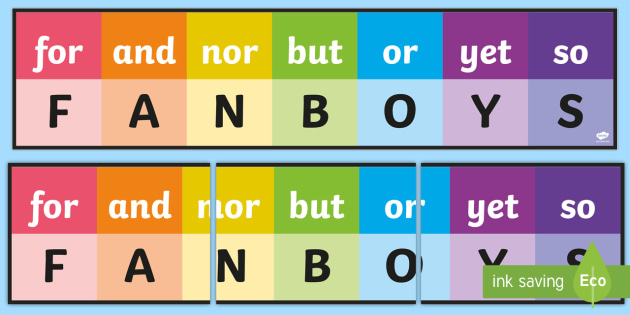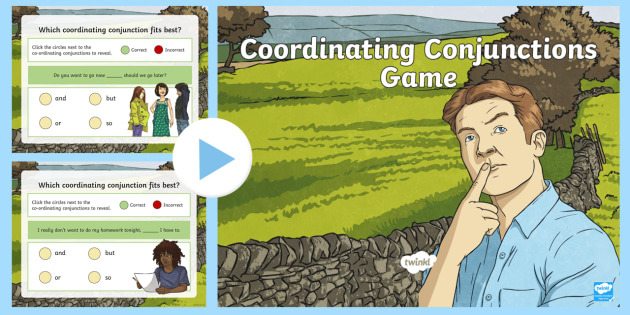
What are FANBOYS?
FANBOYS
What is FANBOYS?
FANBOYS is a handy acronym for remembering the seven most common co-ordinating conjunctions: for, and, nor, but, or, yet and so. They are used to show how ideas relate to each other when connecting two clauses.

What is FANBOYS?
FANBOYS is a mnemonic acronym for remembering the seven most common coordinating conjunctions.
These coordinating conjunctions connect equally important ideas in a sentence. The acronym FANBOYS stands for , and, nor, but, or, yet, and so.
This easy-to-remember memory trick can be used in English when learning about coordinating conjunctions in compound sentences. Here's a fun song that helps kids learn the words that make up FANBOYS.
What are the FANBOYS?
|
F |
A |
N |
B |
O |
Y |
S |
|
For |
And |
Nor |
But |
Or |
Yet |
So |
As shown above and mentioned previously, the FANBOYS are for, and, nor, but, or, yet, and so.
This mnemonic acronym helps us remember the most common coordinating conjunctions in the English language. These words help us connect ideas in a sentence.
Let’s explore what defines coordinating conjunctions and how to use them.
What is a Coordinating Conjunction?
A coordinating conjunction is a connecting word placed between words, phrases, or clauses of equal grammatical value. You use coordinating conjunctions when you want to give the same amount of emphasis on two main clauses or want to compare two related ideas in one sentence.
Coordinating conjunctions are slightly different from other grammatical tools like correlative conjunctions and subordinating conjunctions.
While coordinating conjunctions connect two ideas or independent clauses, correlative conjunctions emphasize the relationship between the two independent clauses using words such as "neither" or "both" in addition to the FANBOYS. The conjunction pairs work together to highlight the relationship.
|
Both Beth and Mary were late to the party. |
Meanwhile, subordinate conjunctions link together an independent clause with a dependent clause. They show a cause-and-effect relationship or a contrast between the clauses. Common subordinate conjunctions include "because," "since," and "though".
|
Since he was able to save enough money, Tony bought a house. |
Grammatically, "so" can work both as a coordinating conjunction as well as a subordinate conjunction. Which one it is depends on the structure and meaning of "so" in the sentence.
|
Coordinating Conjunction (so means therefore) |
It was raining, so I took an umbrella with me when I left the house. |
|
Subordinate Conjunction (so means so that) |
Becky is studying for her test so she can get a good grade. |
For the purpose of this wiki, we’ll focus on coordinating conjunctions. Let’s look more closely at how these conjunctions join words, phrases, and independent clauses.
Coordinating Conjunctions: Joining Words
Coordinating conjunctions can connect words of equal importance in a sentence. These words can be nouns, adjectives, verbs, adverbs, and any other words that are of the same syntactical value.
|
Connecting nouns |
He bought some bread and milk. Did you like the rollercoaster or the Ferris wheel? |
|
Connecting adjectives |
The desert was beautiful yet hot. The dinner was neither tasty nor warm. |
|
Connecting verbs |
The panther ran and darted through the jungle. He hobbled for he had hurt his leg. |
|
Connecting adverbs |
They climbed up the mountain slowly but steadily. Please file into line quickly but quietly. |
The coordinating conjunctions "and" and "or" are also used regularly in a list or a series.
|
She had pencils, a ruler, crayons, and paper in her desk. |
When there are multiple words in a sentence that are of the same importance, commas are used to separate them. In American English, a comma is typically used before the final conjunction in the list or series. This comma is known as the “serial comma” or the “Oxford comma.”
Coordinating Conjunctions: Joining Phrases
Similar to connecting equal words, these conjunctions join equal phrases. The same grammar rules shown above apply in these examples.
|
I picked up my son from soccer practice and my daughter from karate. He drove to the supermarket and then to the hardware store. She was feeling poorly but still smiled. |
Coordinating Conjunctions: Joining Two Independent Clauses
An independent clause can be its own complete sentence because it has a subject and a verb. However, we will often use coordinating conjunctions to join independent clauses to help improve the flow of our work.
Let’s look at a series of independent clauses without the use of conjunctions:
I love staying up late.
I know this makes me tired.
My mother said this will impact my schoolwork.
I didn’t want to believe this.
I recently did poorly on a test.
I will now go to bed earlier.
Too many independent clauses without conjunctions can make a piece of writing, like the one above, feel blocky. Let’s see what happens when conjunctions are added:
|
I love staying up late, yet I know this makes me tired. My mother said this will impact my schoolwork, but I didn’t want to believe this. I recently did poorly on a test, so I will now go to bed earlier. |
When the sentences are written with a coordinating conjunction, the flow is more fluid. However, it’s important to remember to place a comma before the conjunction when connecting two independent clauses. This is because each independent clause is its own complete thought.
|
Twinkl Tip: To check if you're using coordinating conjunctions correctly, to read the words after the use of one of the FANBOYS. The two different parts of the sentence should be able to work as a stand-alone phrase and represent a complete thought. |
How to Teach Coordinating Conjunctions
Learning how to use coordinating conjunctions in writing mainly boils down to practice.
One of the best ways to teach conjunctions, including coordinating conjunctions, is to show sentences using these tools. You can do this on a whiteboard, on worksheets, or even in a game. Your students can then highlight or select the conjunctions in the sentences.
Commas are also an important element in writing sentences with coordinating conjunctions. If there are two independent clauses, a comma is necessary before the conjunction.

If one portion of the sentence is not a complete thought, then a comma is not necessary before the conjunction. The exception to this rule is when using "and" and "or" in a list or series.

Finally, it is possible to start a sentence with a coordinating conjunction. While this shouldn’t be done frequently, it's a good way to add emphasis to a writing piece. And it can make the flow of ideas more effective!
More Examples of FANBOYS used in Sentences
Here are some more examples of sentences using the FANBOYS coordinating conjunctions. You can use them to explain the use and meaning of the conjunctions in more detail. Or just add them to your collection of sentences for future reference.
For
"For" shows a reason or purpose. Using "for" in this way can often be seen as quite formal, and so is usually replaced with the word "because", "since", or "as".
|
The money I earned is gone for I have spent it all. |
And
"And" connects two similar ideas.
|
I have to be at work, and I have to be at the doctor's. This sentence combines two independent clauses: "I have to be at work" and "I have to be at the doctor's." I'm going to learn how to play the guitar and piano. This sentence combines two phrases: "I'm going to learn how to play the guitar." and "I'm going to learn how to play the piano." |
Nor
"Nor" can be interchanged with "neither" and compares a negative contrasting idea. Essentially, it’s the opposite of "and".
|
I cannot go to work, nor can I go to the doctor's. I'm not going to learn to play the guitar, nor the piano. |
But
"But" compares two contrasting ideas or highlights an exception.
|
I can go to the pool, but I won't swim. Idea: I can go to the pool Contrasting idea: I won’t swim. |
The coordinating conjunction but can also be used in a way that says, "not this, but that".
|
The noise wasn’t coming from a computer but rather a phone. |
Or
"Or" highlights two choices.
|
You can choose a blue sweater or a pink sweater. They were either angry or sad. Do you want vanilla or chocolate cake? |
Yet
"Yet" is used in a way to show an exception or a contrast to an idea.
|
There are five cars yet none of them are working. I drank a full bottle of water, yet I still felt thirsty. |
So
"So" is used to show a reaction or consequence. It has the same meaning as "therefore."
|
I ate a lot of cookies, so there are none left. I was feeling anxious, so I went home. |
You might find this a good learning aid when looking at coordinating conjunctions with children in compound sentences, which they will need to be doing from third grade for the ELA Common Core Standards.
You can also see our tailored teaching resources on conjunctions for upper grades.
Looking for more? Join us on social media!
Click the link below to join our group of experienced educators. It's a great way to stay in the loop when it comes to freebies and giveaways!
 Home
Home  Membership
Membership  Customer Support
Customer Support  Create
Create  Blog
Blog 

























